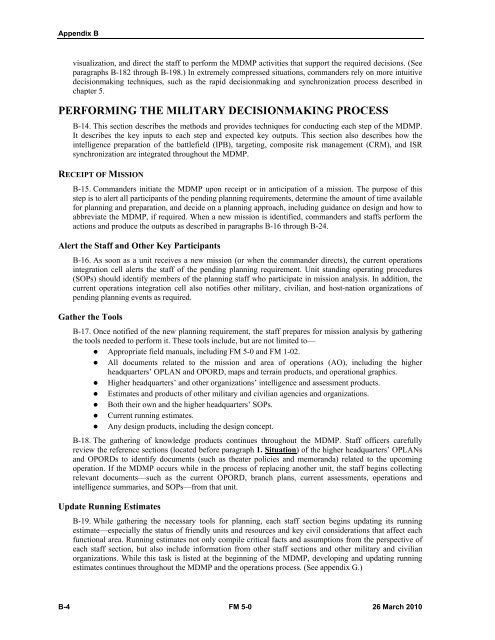FM 5-0, The Operations Process - Federation of American Scientists
FM 5-0, The Operations Process - Federation of American Scientists
FM 5-0, The Operations Process - Federation of American Scientists
Create successful ePaper yourself
Turn your PDF publications into a flip-book with our unique Google optimized e-Paper software.
Appendix B<br />
visualization, and direct the staff to perform the MDMP activities that support the required decisions. (See<br />
paragraphs B-182 through B-198.) In extremely compressed situations, commanders rely on more intuitive<br />
decisionmaking techniques, such as the rapid decisionmaking and synchronization process described in<br />
chapter 5.<br />
PERFORMING THE MILITARY DECISIONMAKING PROCESS<br />
B-14. This section describes the methods and provides techniques for conducting each step <strong>of</strong> the MDMP.<br />
It describes the key inputs to each step and expected key outputs. This section also describes how the<br />
intelligence preparation <strong>of</strong> the battlefield (IPB), targeting, composite risk management (CRM), and ISR<br />
synchronization are integrated throughout the MDMP.<br />
RECEIPT OF MISSION<br />
B-15. Commanders initiate the MDMP upon receipt or in anticipation <strong>of</strong> a mission. <strong>The</strong> purpose <strong>of</strong> this<br />
step is to alert all participants <strong>of</strong> the pending planning requirements, determine the amount <strong>of</strong> time available<br />
for planning and preparation, and decide on a planning approach, including guidance on design and how to<br />
abbreviate the MDMP, if required. When a new mission is identified, commanders and staffs perform the<br />
actions and produce the outputs as described in paragraphs B-16 through B-24.<br />
Alert the Staff and Other Key Participants<br />
B-16. As soon as a unit receives a new mission (or when the commander directs), the current operations<br />
integration cell alerts the staff <strong>of</strong> the pending planning requirement. Unit standing operating procedures<br />
(SOPs) should identify members <strong>of</strong> the planning staff who participate in mission analysis. In addition, the<br />
current operations integration cell also notifies other military, civilian, and host-nation organizations <strong>of</strong><br />
pending planning events as required.<br />
Gather the Tools<br />
B-17. Once notified <strong>of</strong> the new planning requirement, the staff prepares for mission analysis by gathering<br />
the tools needed to perform it. <strong>The</strong>se tools include, but are not limited to—<br />
• Appropriate field manuals, including <strong>FM</strong> 5-0 and <strong>FM</strong> 1-02.<br />
• All documents related to the mission and area <strong>of</strong> operations (AO), including the higher<br />
headquarters’ OPLAN and OPORD, maps and terrain products, and operational graphics.<br />
• Higher headquarters’ and other organizations’ intelligence and assessment products.<br />
• Estimates and products <strong>of</strong> other military and civilian agencies and organizations.<br />
• Both their own and the higher headquarters’ SOPs.<br />
• Current running estimates.<br />
• Any design products, including the design concept.<br />
B-18. <strong>The</strong> gathering <strong>of</strong> knowledge products continues throughout the MDMP. Staff <strong>of</strong>ficers carefully<br />
review the reference sections (located before paragraph 1. Situation) <strong>of</strong> the higher headquarters’ OPLANs<br />
and OPORDs to identify documents (such as theater policies and memoranda) related to the upcoming<br />
operation. If the MDMP occurs while in the process <strong>of</strong> replacing another unit, the staff begins collecting<br />
relevant documents—such as the current OPORD, branch plans, current assessments, operations and<br />
intelligence summaries, and SOPs—from that unit.<br />
Update Running Estimates<br />
B-19. While gathering the necessary tools for planning, each staff section begins updating its running<br />
estimate—especially the status <strong>of</strong> friendly units and resources and key civil considerations that affect each<br />
functional area. Running estimates not only compile critical facts and assumptions from the perspective <strong>of</strong><br />
each staff section, but also include information from other staff sections and other military and civilian<br />
organizations. While this task is listed at the beginning <strong>of</strong> the MDMP, developing and updating running<br />
estimates continues throughout the MDMP and the operations process. (See appendix G.)<br />
B-4 <strong>FM</strong> 5-0 26 March 2010















